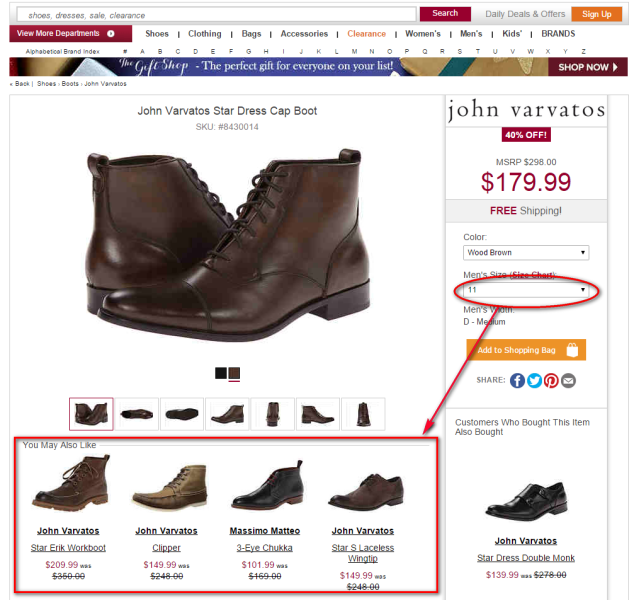7 Resolutions For Higher Website Conversions In 2015
Each year, digital marketers find themselves trying to do more with less. With mobile technologies maturing, analytics entering a decade of being democratized, and personalization technologies enjoying increasing adoption, online marketers have never needed to learn more and do more just to keep up. While new advancements and opportunities arise constantly, the beginning of a […]

Each year, digital marketers find themselves trying to do more with less. With mobile technologies maturing, analytics entering a decade of being democratized, and personalization technologies enjoying increasing adoption, online marketers have never needed to learn more and do more just to keep up.
While new advancements and opportunities arise constantly, the beginning of a new year always seems to be a good time for planning and goal setting. If you share responsibility for the success of a website, here’s a list of seven ideas you may want to include in your 2015 resolutions.
1. Provide Consistent Multi-Channel Experiences
Multi-channel isn’t just a buzzword — it’s a reality. Your prospects and customers use various channels to interact with you: your website, mobile site or app, email, social media, phone and brick-and-mortar stores. Their experiences in each affect their perception of your company.
Consistency is critical for multi-channel success. A poor experience within any one of your channels can instantly erode customer goodwill and tear down your brand’s credibility.
Consistent multi-channel experiences don’t happen by accident. Furthermore, they are not limited to uniformity of visual design; they should also translate to other aspects of your marketing mix (e.g. variety and availability of products, promotions, and after-sales support reliability). It doesn’t make sense, for instance, not to allow customers to pick up their online purchases from a physical store.
More importantly, a seamless multi-channel experience takes into account what consumers want to accomplish on each channel. Identify which channel is appropriate for which tasks, and optimize the platform accordingly for usability and user experience.
For example, if a majority of your customers use social media mainly to ask for support, then optimize the channel for that. Assign a dedicated customer support staff for your social accounts so you can respond to requests in a timely manner.
2. Improve Mobile UX And Usability
Mobile devices are now considered the screen of choice for many consumers. eMarketer’s US Digital Media Usage: A Snapshot of 2015 predicts that up to 72.8% of mobile phone users will access the internet on their devices at least once a month. This should be great news for marketers, right? Not quite.
Mobile continues to perform poorly for conversions. For one, mobile is still not seen by consumers as a conversion device. Aside from the inherent difficulties of smaller screens and the persistence of security concerns, most mobile sites and apps suffer from usability issues that deter customers from transacting. For instance, some mobile ecommerce sites continue to frustrate users by requiring them to fill out numerous form fields before they can complete their purchase.

Even minor improvements such as using predictive technologies to assist in filling form fields on mobile — like automatically identifying card type based on card number — can go a long way in helping users.
Secondly, there’s still the misconception among marketers that mobile UX issues will be instantly addressed either by having a responsive design or building a mobile version of the website. They won’t. Your responsive or mobile site will only be useful if it’s built based on the specific needs and behaviors of users on that channel — which you can learn by checking your mobile analytics data.
So, if you want to solve the mobile conversion paradox for your company, get ready to pull up your sleeves for some number crunching. Do the math, and follow the numbers.
3. Segment And Target Wisely
With the multitude of affordable (and even free) analytics tools out there, there’s no reason not to segment. With Google Analytics, for instance, you can create specific segments of your visitors based on their actions and behavior. You can then tailor your content, promotions, and other campaign elements based on these insights.
Segmentation and targeting are, in a sense, the first steps to personalization. Not doing these two is the easiest way to lose relevance.
Don’t take your spray-and-pray habit into the next year. Start segmenting your customers based on their demographic and psychographic profiles, online behaviors (e.g. cart abandoners, frequent visitors, or high-ticket buyers), and the unique characteristics of your business (e.g. product lifecycle, seasonal demands, etc.). Combine these insights so you can create more compelling messages, more targeted offers, and useful content for the different aspects of your marketing campaigns.
4. Personalize And Do It Right
While we’ve seen a greater degree of personalization on the websites of larger companies, an overwhelming majority of websites don’t have personalization elements in place. According to the Econsultancy Conversion Rate Optimization Report 2014, only 25% of companies are using website personalization — this, despite the clear benefits of personalized web experiences on conversion rates.
If you haven’t started on personalization, suffice it to say that you’re leaving a lot of money on the table. There are now a lot of easy and affordable third-party services that can help you start personalizing your website, so there aren’t many valid excuses left for not getting started.
Those with integrated personalization tools in their websites can’t rest on their laurels, either. For instance, if you have product recommendations on your ecommerce site, check if you can enhance the experience further by making sure the products being recommended are actually in stock in a customer’s size.

If your customer used filters to get to a certain product, it would be a good idea to match product recommendations to these filters. It might annoy your customer to click on a recommended product only to find out it’s not available in the color or size he/she wants.
Personalizing deeply can sometimes spell the difference between providing delightful experiences and setting customers up for disappointment.
5. Go Beyond A/B Testing And Adopt A Structured Approach To Conversion Rate Optimization
Marketers often use the terms “website testing” and “conversion rate optimization” interchangeably, as if they are the same thing. Unfortunately, these folks don’t realize that testing is not the whole picture until they reach the plateau — the local maximum point — in their testing efforts.
You know you’re at the local maximum point when your new versions aren’t winning against the control as much as they did when you first started testing. Higher converting variations of web pages become harder to come by, simply because all the low hanging fruit and the best ideas have been used up.
The point is, while A/B testing is one of the most useful tools for learning what works (as opposed to working from gut instincts and opinions), you do your company and yourself a disservice by limiting your optimization efforts to testing.
Instead, you should:
- Understand what circumstances would make testing inappropriate.
- Focus on profit improvements and not testing velocity.
- Have tactical and strategic testing tracks going on side by side.
- Pick flexible testing tools that allow you to test non-trivial ideas.
Stop obsessing about A/B testing and start devoting attention to other activities that are fundamental to the success of your conversion rate optimization program: primary user research, experientially looking at every touch point, and re-examining your business model and your organization. Remember, you’re not trying to win more tests, you’re trying to grow a business.
6. Don’t Be Afraid To Redesign Your Website If Necessary
Some marketers are afraid of making radical changes to their websites for fear that the new design may fail to bring more conversions or even perform worse than the original. Most of the time, however, the failure of a website redesign comes from the lack of or poor implementation of a conversion-centric framework during the project.
You’re not going to make quantum leaps past some point if you always just perform incremental tests on what you have. Instead of focusing on figuring out which button color, font type, or spacing converts better, uncover the serious issues that majority of your users encounter by running usability studies. You can also review your architecture and user scenarios to see if your site is optimized for the different roles and tasks of your visitors.
Granted, if your site is performing well and usability tests don’t reveal any red flags, doing a full redesign just because you’re bored with the old look is rarely a good idea. But if your site (like many) has major flaws that are affecting the entire user experience, you’re likely to make greater gains with a full conversion-centered redesign than by optimizing bits and pieces.
7. Invest In Conversion Rate Optimization Learning And Skill-Building
One trend we saw this year was bigger companies starting to beef up their conversion capabilities by creating and filling new, full-time conversion rate optimization (CRO) positions in their organization. These companies now have either a team or an entire department responsible for CRO initiatives.
Imagine in the coming year going up against a company with a dedicated team not just for website testing, but also for doing usability studies, enhancing user experience, creating persuasive copy, personalizing content and offers, and so on.
Make no mistake: that’s exactly the kind of competition you’re facing.
Yes, start-ups or smaller companies are at a disadvantage given their limited resources; however, that doesn’t mean you can’t at least strive to get your company started with website optimization. If you’re in charge of online marketing, be an advocate for CRO by encouraging your team members to learn about the discipline, and actively support or recommend the inclusion of CRO training as part of human resource development plans in your organization.
So, What Will You Resolve For 2015?
You probably have a limited budget and an even more limited amount of time, so be realistic in what you set out to do. The pace at which technology advances will always be greater than your ability to implement new optimization tricks.
Pick the one or two areas that will really move the needle for your company in 2015, and focus your resolutions around those. Then this time next year, you can look back at what you’ve accomplished, take an inventory of the latest innovations, and move on from there.
Contributing authors are invited to create content for MarTech and are chosen for their expertise and contribution to the search community. Our contributors work under the oversight of the editorial staff and contributions are checked for quality and relevance to our readers. MarTech is owned by Semrush. Contributor was not asked to make any direct or indirect mentions of Semrush. The opinions they express are their own.
Related stories